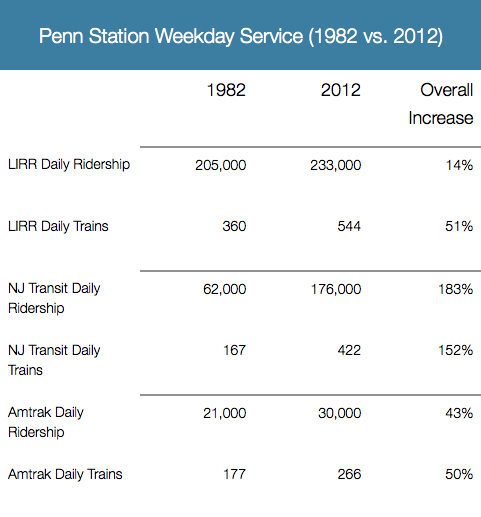Stipulations
The City of New York stands at a crossroads. For the past decade, Manhattan’s commercial districts have experienced an unprecedented building boom. Capital improvements that have been on the table for years are finally underway. But looking ahead, as unemployment hovers at around 8% and the fiscal footing of key metropolitan agencies is unstable, the region needs to make difficult decisions regarding its future. In one direction, the city can continue to invest in its infrastructure and real estate development to promote growth and prosperity for the region as a whole. In the other direction, the city can take austerity measures to conserve resources, but in the process, risk entering a period of decline that will threaten the region’s success.
These circumstances may sound familiar, but the year is not 2012. It is 1959. And over the next two decades, instead of investing in wide-reaching mass transit projects, New York City would act conservatively, abandoning many of the pro-growth policies that created its post-war prosperity. Transit workers went on strike, the Second Avenue Subway was abandoned, and the original Penn Station was demolished. As subway ridership declined, revenues fell and the transit authority cut back on station maintenance and the purchase of new equipment. In turn, fewer people rode the deteriorating subway, revenue fell, and the cycle of decline continued New York City was unable to simultaneously maintain previously-successful transit systems while adapting to changes in the transportation and real estate demands of the region, chiefly due to the rise of the automobile and exodus of middle-class residents to the suburbs. The city had stalled because political leaders chose to curtail investment instead of planning ahead for the region’s changing needs.
There are obvious parallels to the present day. Manhattan’s commercial districts have indeed experienced tremendous growth over the past decade. Several large capital projects will be completed in the upcoming years. Yet stubborn unemployment has shrunk the tax base, and transit agencies such as the MTA and NJ Transit face rising budget deficits that threaten future investment. The City of New York does indeed stand at a crossroads. Still, no one has ever suggested that New York risks returning to the extreme hardships of the 1970s and 1980s. But moving forward, it is imperative that metropolitan agencies make responsible investments in transportation infrastructure and real estate development so that the region will continue to prosper in the future.
Much like the fundamental trend away from rail and towards the automobile in the 1950s and 60s, today, the trend is reversing. As gas prices continue to escalate, the middle class shrinks, and commuters increasingly choose to travel by rail, the demand for effective commuter rail and mass transit systems is quickly rising. But the region’s transportation infrastructure is outdated and cannot keep up with this increasing demand. At the heart of this problem lies the heart of the system: Penn Station. What began as a grand ode to the Pennsylvania Railroad Company’s success is today an unnavigable substructure beneath the Madison Square Garden complex. From a design perspective, Penn Station suffers from dual capacity problems. First, the 100-year-old pair of single-track tunnels that feeds trains into Penn Station from New Jersey severely limits the number of hourly trans-Hudson crossings. Second, Penn Station itself has a shortage of tracks and platforms, which creates unnecessary traffic on the already overburdened system. In spite of its shortcomings, Penn Station remains the busiest transit hub in North America. As New Jersey’s population is expected to increase by 1.7 million residents over the next 20 years, Penn Station cannot accommodate more trains during peak hours. Ridership continues to grow, but without the possibility of increases to service. For Amtrak, at a time when high-speed rail has become the focus of the future, Penn Station is not prepared to usher in a new generation of trains and passengers. Whether Penn Station will cease to be able to accommodate the increasing number of trains and passengers has not become a question of if, but rather a question of when.
As a result of the problems associated with Penn Station, over the last several years a number of proposals have come to the forefront of the debate regarding how to address the numerous transit challenges facing the region. Many of these proposals call for the expansion and renovation of Penn Station’s facilities and tunnels. However, these plans fail to grasp the idea that greatness is not born out of timidity. The transit hub that the New York metropolitan region needs will never be located beneath Madison Square Garden, no matter how many bells and whistles are attached to it. In addition, these transit proposals fail to recognize that where there are great challenges, there are also great opportunities, especially in promoting real estate development and permanent regional job growth. Currently, New York is engaged in a massive city planning effort to develop Manhattan’s West Side. From 14th Street to 61st Street west of 9th Avenue, widespread changes to the urban landscape are underway. Some of these changes will add tens of thousands of new apartments and millions of square feet of commercial space to Manhattan’s West Side. Thus, in order to responsibly, yet comprehensively, propose the next step for New York’s transportation infrastructure, it is important to keep certain goals in mind:
1) Avoid the mistakes of the past by looking forward, not just to the immediate future, but to the long-term future;
2) Find a way to dramatically increase rail capacity for trains originating west of the Hudson River;
3) Develop a strategy to plan for the sustained growth of untapped developments within Manhattan’s West Side;
4) Contain costs and schedule construction aggressively so that the public does not continue to wait around as they have become so accustomed to doing; and
5) Restore pride in the metropolitan region’s great transportation infrastructure.




